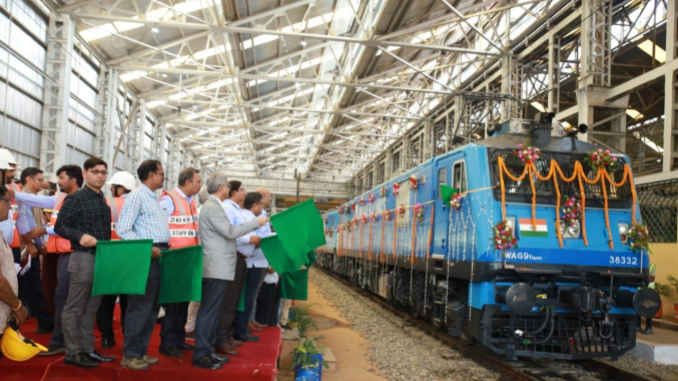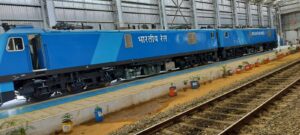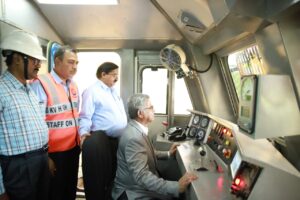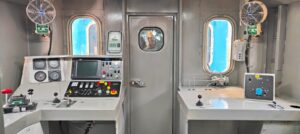
Shri D.P. Dash, General Manager of Chittaranjan Locomotive Works (CLW) flagged off The 1st WAG-9 Twin locos in the gracious presence of Sr. officers & staff. This new twin locos was manufactured in house with no additional input cost and capable of running at 12000 HP.

More Details:
Setting up Record in Manufacturing of Locomotives:
Chittaranjan Locomotive Works created a record by manufacturing 250 locomotives in 134 working days in the current fiscal. CLW produced as many as 250 electric locomotives (WAG-9 HC,) in 134 working days, as against 183 days last year.
CLW creates another ‘Make in India’ record in locomotive production. Despite post COVID challenges which put the supply chain of global chip manufacturing out of gear, the Chittaranjan Locomotive Works (CLW)- the first locomotive manufacturing factory of Indian Railways is breaking all the previous manufacturing records.
The Production Unit of the national transporter accelerated its production to a record level this year. According to the details shared, Chittaranjan Locomotive Works produced as many as 250 electric locomotives in 134 working days, as against 183 days last year.
This factory took up the challenge of manufacturing 540 locomotives ordered by the Railway Board against the previous out turn of 436 Locomotives in 2022-23. CLW set its priority and accelerated the manufacturing to 55 locomotives in June, 65 in July and 57 in August setting new records every month from 67 locomotives produced in the first two months.
The production of Locomotivesup to August is 244 which is 41% higher compared to 173 produced by the same time previous year. The first 100 locomotives took 70 days against the previous best of 73 days, 200 locomotives were turned out in 112 days against the previous best figure of 143 working days.
- The bogie assembly shop also had an excellent Production of 200 bogies up toAugust against previous best of 144 bogies last year recording an increase of 38% over last year.
- In the financial year 2019-20, the CLW developed 250 locos in 190 days, in the financial year 2020-21, Chittaranjan Locomotive Works produced 250 locos in 188 working days, in FY 2021-22. CLW produced 250 locomotives in 167 days while in FY 2022-23 it had achieved production in 183 days.
- Thus, the time taken by the locomotive factory has reduced by 56 working days since the financial year 2019-20 and 49 days compared to 2022-23 for manufacturing 250 locomotives.
- The enhancement of production was possible due to a series of interventions to have streamlined the supply chain, optimization of processes of manufacturing and strengthening the internal quality assurance system.
CLW has also introduced a number of innovative HR initiatives since June 2023 under one to one promotion where the retiring employees hand over the promotion letter to the new incumbent to ensure timely promotion of employees and recognition of good work by selecting ‘Man of the Month‘ to motivate employees.

CLW Achieves Remarkable production of Motorised Bogies:
- The Bogie Assembly Shop of Chittaranjan Locomotive Works (CLW) achieves a record-breaking Production. In the fiscal year 2023-24, up to 31st August 2023, BSA has manufactured a record 200 Loco sets of Motorised Bogies.
- This accomplishment represents the highest production between April and August in any fiscal year. This achievement reflects CLW’s endeavour for quality, innovation and timely output in locomotive manufacturing.
A Beacon of Innovation and Sustainability:
Chittaranjan Locomotive Works (CLW), India’s first locomotive factory and the world’s largest, reached a significant milestone in September 2023, marking its 73rd year with the production of its 12,000th locomotive.
CLW’s historical production includes 2,351 Steam Locomotives between 1950 and 1972, 842 Diesel Locomotives from 1968 to 1993, and 8,807 electric locomotives of various types up to September 28, 2023.
- CLW made history by becoming the first production unit in developing countries, the second in Asia, and the fifth globally to manufacture state-of-theart 3-phase GTO Thyristor-controlled Electric Locomotives.
- In 1998, it introduced the indigenous 6,000 hp freight electric locomotive, WAG-9, followed by the passenger version, WAP-5, in 2000-01. CLW has consistently advanced through technology collaboration, acquisition, and indigenous development.

In 2015, CLW transitioned from GTO-based technology to IGBT, significantly enhancing propulsion technology. CLW also played a pivotal role in sharing technology with local industries to meet global standards for component sourcing, with focus on indigenization (>99%) import substitution has resulted in a substantial reduction in locomotive costs from 35 cr in 1998 to 10.42 cr in 2023.
The surge in electrification of railway tracks and demand for higher freight and passenger loads prompted CLW to increase production. Between 2017-23, it manufactured 2495 locomotives (@416 per year). CLW has clinched two impressive entries in the Limca Book of Records for its astounding production.
Despite challenges posed by post-COVID disruptions, CLW exceeded expectations by accepting an order for 540 locomotives in 2022-23, and stepped up production by 41% increase over the previous year till Aug.2023. These efforts position CLW to fulfil roughly 50% of Indian Railways locomotive needs.
- CLW’s commitment to environmental responsibility predates global awareness. It initiated an industrial green revolution by planting trees, transforming arid land into greenery. Substantial tree planting efforts continued over the years.
- CLW also championed rainwater harvesting, creating water bodies that attract migratory birds. The factory’s abundant flora and fauna make it a year-round spectacle. Moreover, CLW installed solar photovoltaic systems on rooftops, generating 6 MW of solar power and reducing carbon emissions.
Recognized for its sustainability initiatives, CLW holds certifications for environmental management, energy management, occupational health standards, and quality management, including the prestigious Golden Peacock award for Environment Management.
Source: CLW- Press Release | Images Credit: CLW

